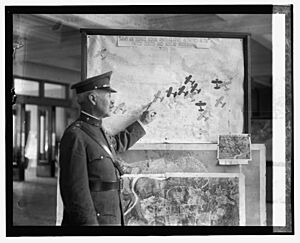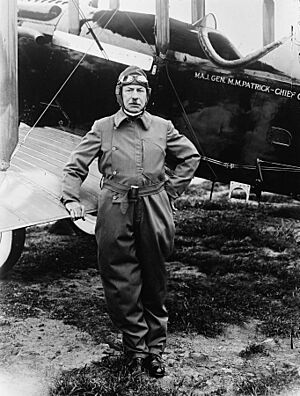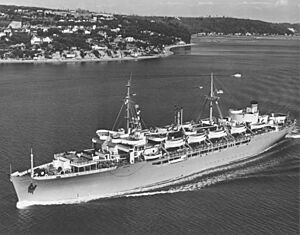Mason Patrick facts for kids
Quick facts for kids
Mason M. Patrick
|
|
|---|---|
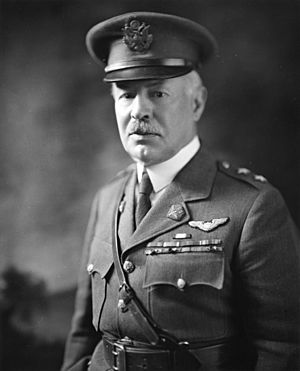
Major General Mason M. Patrick, U.S. Army Air Corps
|
|
| Birth name | Mason Mathews Patrick |
| Born | December 13, 1863 Lewisburg, West Virginia, US |
| Died | January 29, 1942 (aged 78) Walter Reed General Hospital Washington, D.C., U.S. |
| Buried |
Arlington National Cemetery, Arlington County, Virginia, U.S.
|
| Allegiance | |
| Service/ |
|
| Years of service | 1886–1927 |
| Rank | |
| Commands held | 1st Engineer Regiment US Army Air Corps |
| Battles/wars | World War I |
| Awards | Distinguished Service Medal French Legion of Honor Italian Order of St. Maurice and St. Lazarus Order of Leopold Order of the British Empire |
| Other work | Author, The United States in the Air (1928) Public Utilities Commissioner, District of Columbia |
Mason Mathews Patrick (born December 13, 1863 – died January 29, 1942) was an important general officer in the United States Army. He led the United States Army Air Service during and after World War I. He later became the very first Chief of the United States Army Air Corps when it was created in 1926.
Patrick was born and grew up in Lewisburg, West Virginia. At 18, he joined the U.S. Military Academy at West Point. He finished second in his class, right behind his friend John J. Pershing. Early in his career, he worked as a Chief Engineer in Cuba and along the U.S.-Mexico border. During World War I, he served in France. General Pershing chose him to lead the Air Service in May 1918. Under his leadership, the Air Service set up important testing sites in Ohio and Texas.
In 1926, Patrick helped create the Air Corps Act. This act changed the Air Service into the United States Army Air Corps. Patrick was the commander of the Air Corps until he retired in 1927. He passed away in Washington, D.C. in 1942. Today, Patrick Space Force Base in Brevard County, Florida is named after him.
Contents
Early Life and Education
Mason Mathews Patrick was born in Lewisburg, West Virginia on December 13, 1863. His parents were Alfred Spicer Patrick and Virginia (Mathews) Patrick. His father was a surgeon during the American Civil War. Mason attended local schools in Lewisburg. After graduating, he taught at his old high school for two years.
A Career in the U.S. Army
West Point Days
At 18, Mason Patrick began his journey at the U.S. Military Academy at West Point on July 1, 1882. He was very good at math and engineering. People also said he spoke excellent French. He was known for being smart and well-read.
Outside of classes, Patrick sometimes got into minor trouble. He was cited for things like using tobacco or being late. He even got in trouble twice for "sliding down the banister"! At West Point, he became good friends with John J. Pershing. They were the top two students in their senior class. Because he did so well, Patrick chose to become an engineer in the Army. He became a second lieutenant on June 12, 1886. For the next three years, he studied at the Engineer School of Application in New York. He became a first lieutenant in July 1889.
Patrick returned to West Point in 1892 to teach engineering for three years. From 1897 to 1901, he worked on improving the Mississippi River. He was promoted to major in 1904. He also served as the Chief Engineer for the Army in Cuba from 1907 to 1909. After that, he worked on river and harbor projects in Virginia and Michigan. He also helped raise the USS Maine ship in Havana Harbor. During this time, he became a lieutenant colonel in 1910 and a colonel in 1916. He then commanded the 1st U.S. Army Engineers along the U.S.-Mexico border.
Leading in World War I
Patrick was promoted to brigadier general on August 5, 1917. He went to France that same month after America joined World War I. In September, he became the Chief Engineer for the American forces there.
In May 1918, his old friend General John J. Pershing chose Patrick to lead the Air Service. He was then promoted to temporary major general in June. Patrick took over from General Benjamin Foulois because Pershing felt the Air Service needed better organization. When Patrick arrived, the Air Service headquarters was described as "a tangled mess." He brought in experienced officers and improved how things were run.
Patrick helped organize 28 air squadrons for a major battle. With help from French, British, and Italian units, the total air force had 1,481 aircraft. This made it the largest air operation of the war. Patrick stayed with the Air Service until June 1919. After the war, he returned to the U.S. and worked on various engineering tasks.
Between the Wars
Patrick was again made Chief of the Air Service on October 5, 1921. He held the permanent rank of major general.
Under Patrick's leadership, the Air Service created new testing centers at Wright Field in Ohio. They also built a large training center in Texas. It was there, in 1922, that Patrick learned to fly for the first time! He earned his Junior Airplane Pilot rating at the age of 59.
During this time, Patrick had some challenges managing his Assistant Chief, Billy Mitchell. Mitchell was very outspoken and wanted air power to be completely separate from the Army and Navy. He often spoke directly to the press, which went against military rules. Patrick made it clear that he was in charge of all decisions.
Patrick was worried about military weaknesses in the Pacific Ocean. He sent Mitchell on a trip to survey the Pacific and the East. Mitchell's report pointed out problems in Hawaii. Patrick called it a "theoretical" but valuable look at how air power could be used in the future.
In 1924, Patrick chose Henry "Hap" Arnold to lead the Air Service's Information Division. Arnold worked closely with Billy Mitchell. Mitchell used this division to promote his ideas about air power independence. Later, Mitchell was put on trial (court-martialed) for criticizing Army and Navy leaders. He said they were making bad decisions by investing in battleships instead of aircraft. Arnold and other officers supported Mitchell, even though they were warned it could hurt their careers. After Mitchell was found guilty, Arnold and others continued to share pro-Mitchell information. In 1926, Patrick had to discipline them. He transferred Arnold to a different base, far from aviation, to avoid another public problem.
Creating the Air Corps
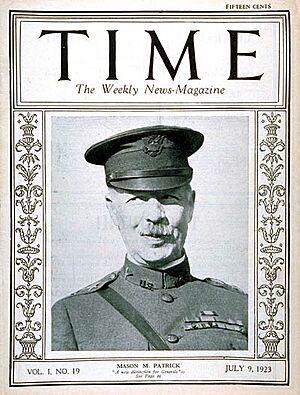
In early 1926, the U.S. Congress looked at ideas to make the air force more independent. Patrick suggested that the Air Service become a semi-independent part of the War Department, similar to how the Marine Corps works within the Navy. He asked for a "five-year plan" to grow and develop the air force.
His idea led to the Air Corps Act, which became law on July 2, 1926. This act created the United States Army Air Corps from the existing Air Service. The Air Corps kept its "Prop and Wings" symbol. Patrick became the first Chief of the Air Corps.
Retirement and Later Life
Patrick retired from the Army on December 12, 1927. He stayed in Washington, D.C. and advised Presidents Herbert Hoover and Franklin D. Roosevelt. In 1928, he published a book called The United States in the Air. From 1929 to 1933, he served as a Public Utilities Commissioner for the District of Columbia.
Mason Patrick passed away at Walter Reed General Hospital in Washington, D.C. on January 29, 1942. He was buried in Arlington National Cemetery on January 31, 1942.
Awards and Honors
Patrick received many military awards and honors, including:
- Distinguished Service Medal
- Spanish War Service Medal
- Mexican Border Service Medal
- World War I Victory Medal
- Commander of the Order of Leopold (Belgium)
- Knight Commander of the Order of the British Empire
- French Legion of Honor
- Italian Order of St. Maurice and St. Lazarus
Places Named After Patrick
A U.S. Navy ship and a U.S. Space Force base were named in honor of Mason Patrick:


